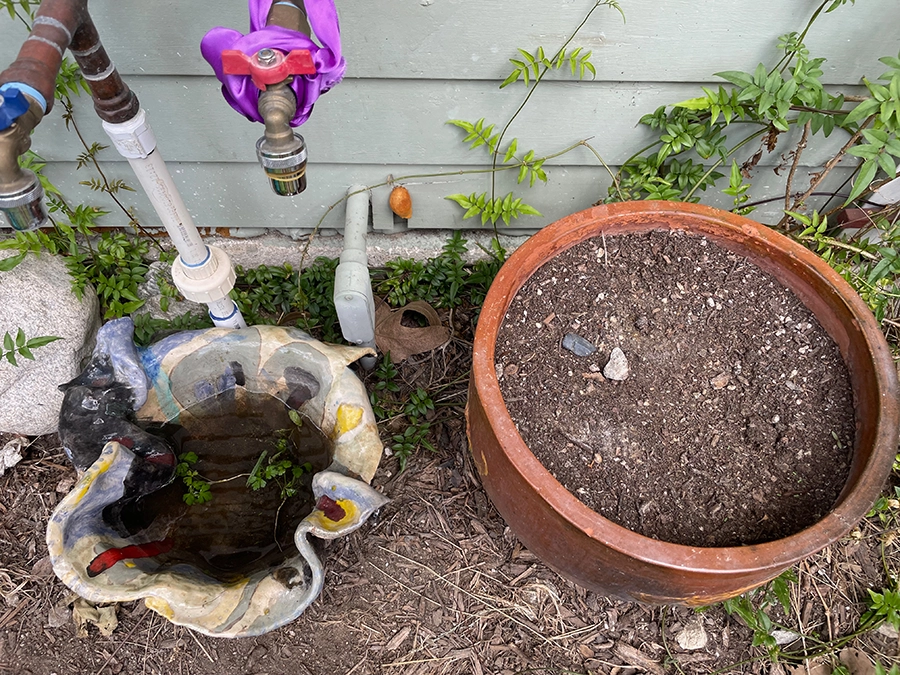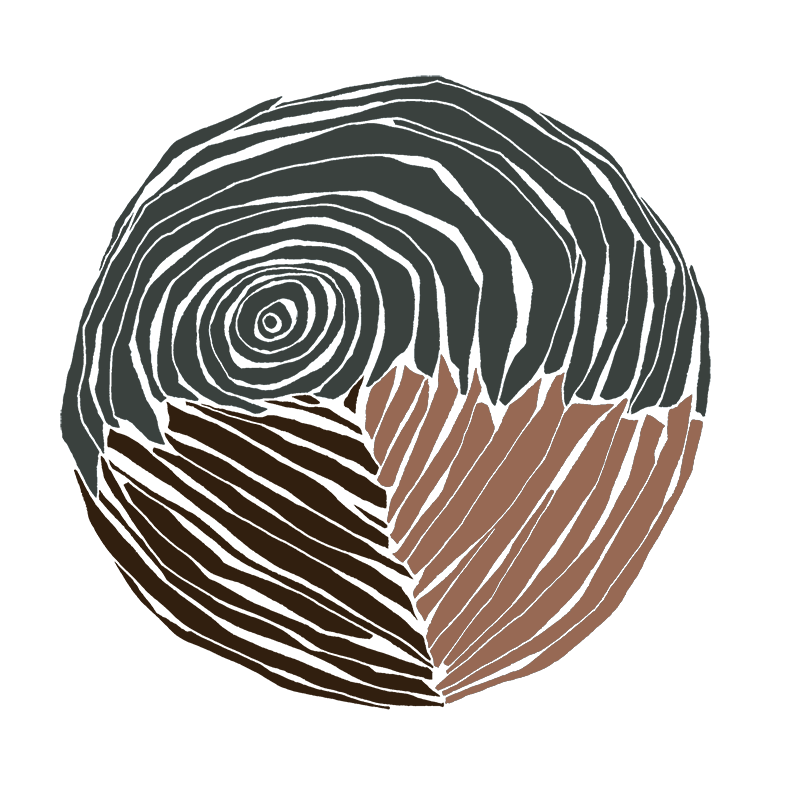Lucia Fabio, cont.
We prepared for the first rains after the fires near the end of the month. The land was so dry at this point. Not only had it not rained since May the previous year, but the fires had sucked any remaining moisture out of the earth. As we emptied out the rain barrels the water wouldn't absorb into the dry earth; the soil was completely hydrophobic. We did the best we could by collecting the rainwater in buckets to avoid capturing ash in the rain barrels and cistern. We also tried to divert this first rain from going into the storm drains. It was so much labor, and I know that we were one of very few households that even attempted to mitigate the run-off. The oceans were black after the first rainfall (and after each subsequential rain). I have no idea when the coast will be clean and safe again.
The fires brought together multiple communities all around Los Angeles; mutual aid groups emerged and you could feel the energy of everyone wanting to help. I became part of LA AYUDA—an artist-led volunteer group providing vetted communications and support to those most impacted by the LA fires. We organized an art benefit at Felix Art Fair during art fair week in February. Artists were asked to create works based on the idea of stones to be sold at the fair. Our new studio was a drop-off site and we received over two hundred submissions. I decided to donate two works to the benefit and created two vessels that held lithops—or more commonly known as living stones. Not only was this the first time that I showed my ceramics in public, but it had been a very long time since I had shown any work. We raised nearly $50,000 and are planning a second event at the end of May to sell the remaining works to reach our goal of $60,000 which will be distributed to three organizations who offer fire relief to undocumented, BIPoC, and essential workers. This was so much work, but I felt so fulfilled after we deinstalled the fair, utterly exhausted, but fulfilled. And I am so grateful to have met those who initiated this collective and who invited me to be part of the main group. I find their energy and commitment to activism an inspiration and am looking forward to organizing when there is another need.

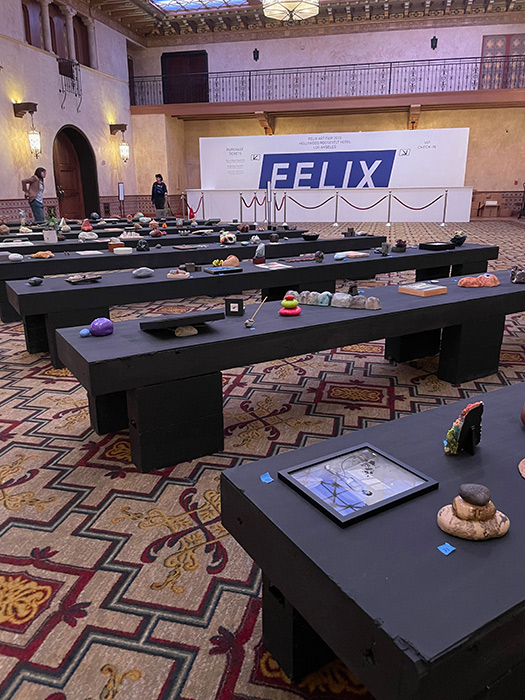
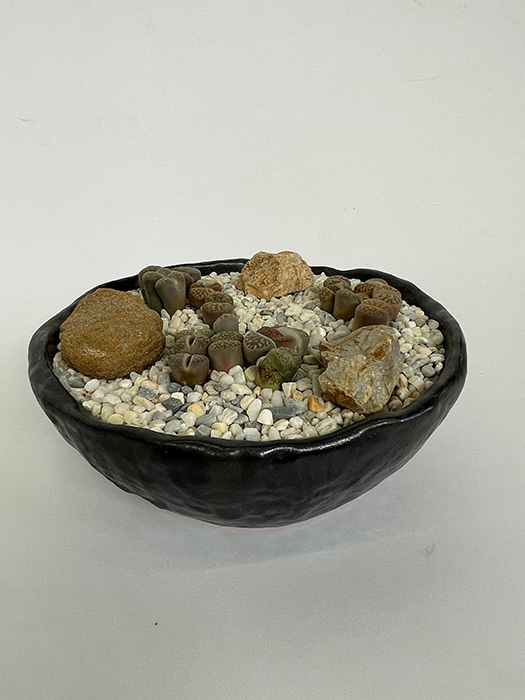
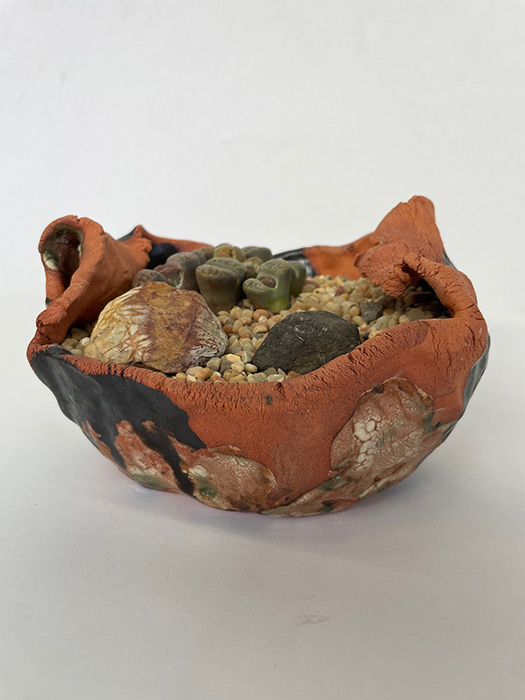

While weeding, I found the roots of an old geranium covered in mycelium. Even though the soil has been contaminated by the ash, this shows me that everything will be okay. There are enough microbiomes and activity in the soil to remediate itself.
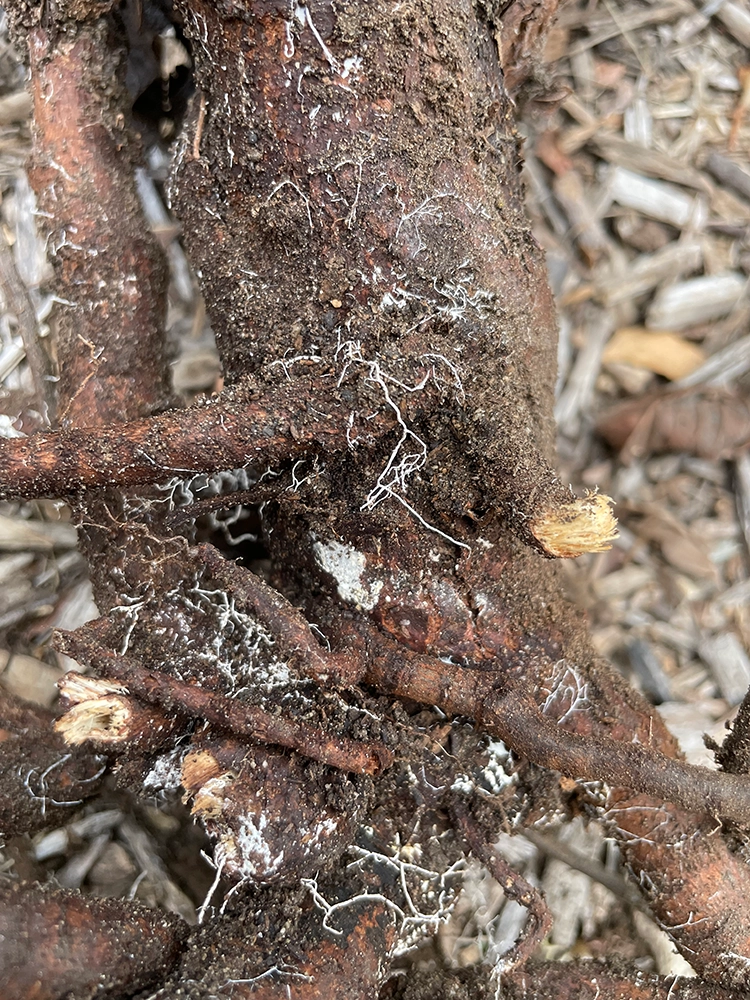
In September of last year, I helped Carolina Caycedo with four seed mandalas for her exhibition We Place Life at the Center / Situamos la vida en el centro at the Vincent Price Museum. I had introduced her to seed steward, Azita Banu and grew some of the seeds that were used to create these pieces. I attended the show one last time to visit the seeds before the show closed. The seeds were supposed to be given away to the public, but it never happened due to complications with the fires. Instead, these seeds will be distributed during my year-long residency at Art in the Park (see April).

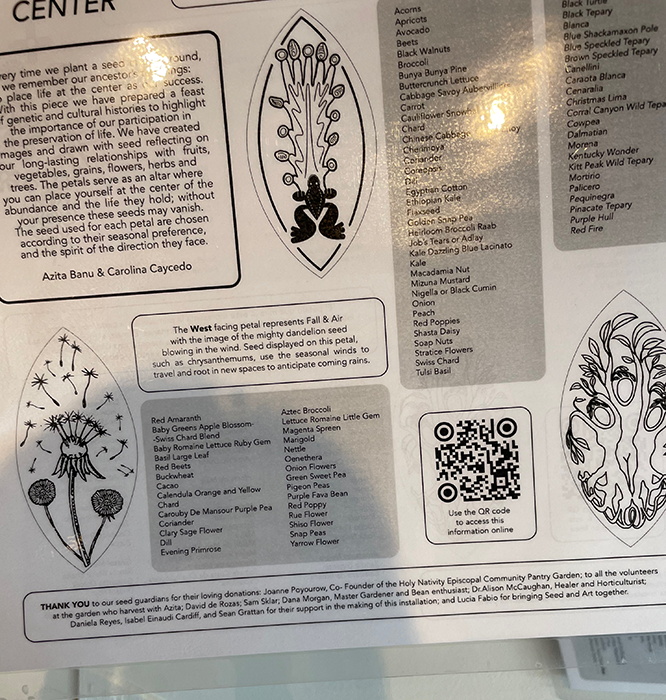
March
In this part of the US, you are not supposed to plant tropical milkweed for monarch caterpillars since these plants don't go through the same dormancy cycles as the native milkweed. Which means that butterflies will lay eggs while it's too cold and there isn't enough food to eat. I had thought I cut down this tropical milkweed (which was a volunteer) but in the midst of the craziness it had regrown and was used as a host plant. A friend contacted me about a massive native milkweed bush around the corner of her house and we transported the caterpillars nearly 5 miles to give them a chance at survival. I'm grateful for my nature loving community.

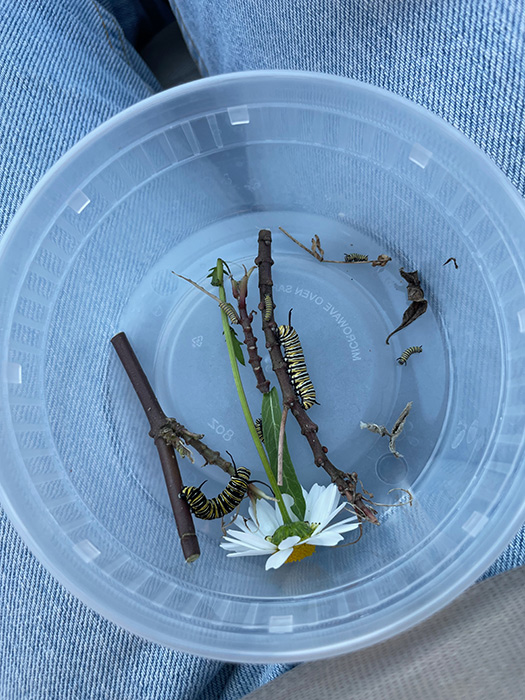
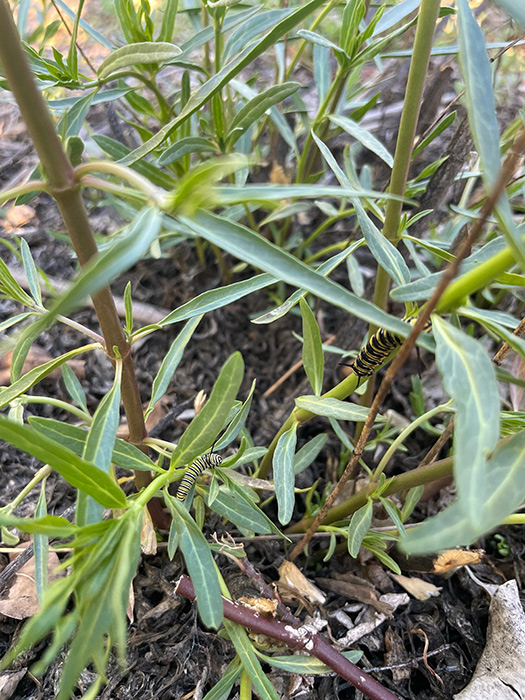
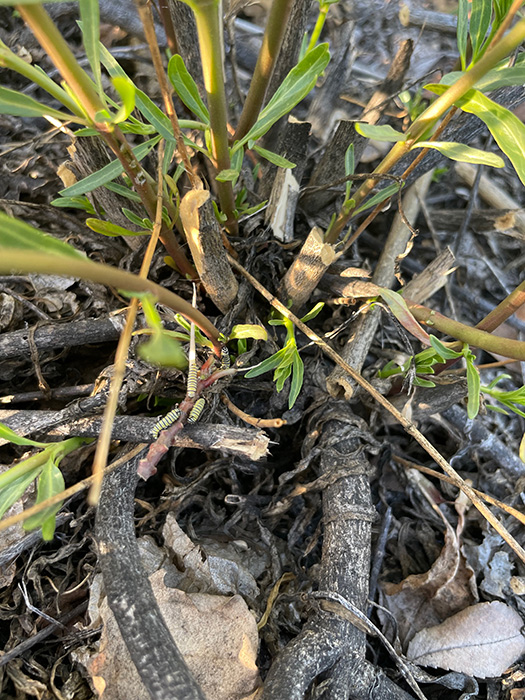
I attended "Live on Earth—Ecofeminism and Art: a Planetary Symposium at Art Center" organized by the Brick and West Den Haag. The first panel was with Italian-American feminist activist, writer and teacher, Silvia Federici. I could not stop taking notes [.pdf] during the entire symposium—things were being discussed that I had been struggling with internally. It was a validation that these conflicting and urgent feelings about the state of the world are communally shared.
Note: I always think that March is the fourth month for some reason, so please disregard the incorrect date on the pdf.
I recently started a practice of not doom scrolling on my phone at night. This has been a difficult thing to implement, but very slowly I am returning my attention to books. The following books are on my bedside (and they are still there as I write this in May).
- The Invisible Harvest: A Microhistory of Heretical Herbs by Bethan van Rijswijk
- Il Giardino Segreto, by Frances Hodgson Burnett (The Italian translation of The Secret Garden)
- "The Four Seasons of the Spirit and Achieving the Miracle of Contentment" by Manly P. Hall
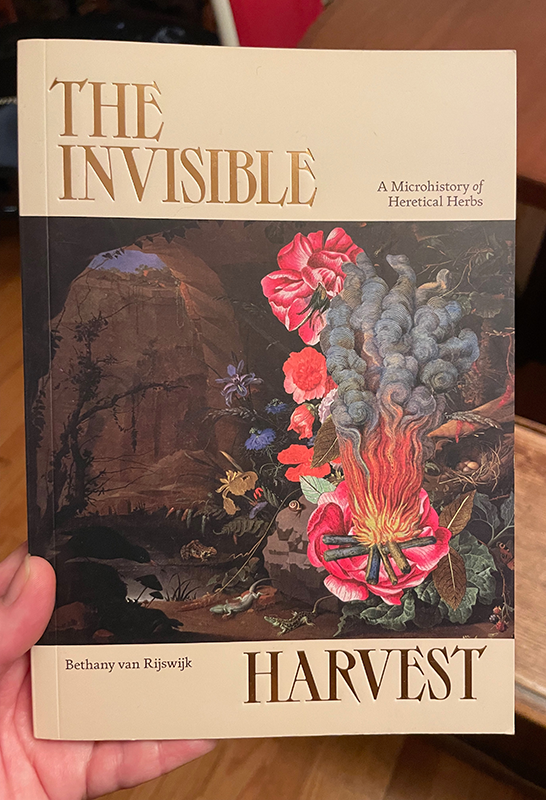
Two years ago, we planted a fig tree over my placenta. The fig tree was given to me by my father, who obtained it from my aunt, who got a clipping from a family friend who brought it back from Italy. Unfortunately, something happened to it and it needs to be removed. A friend suggested planting an olive tree—both for its upwards canopy and its connection to my ancestorial lands. I went deep into research and found a Sicilian variety: Nocellara del Belice. I texted an image of the proposed planting spot to a grower in northern California before he told me his beautiful and mature trees were $3,500 plus shipping and installation. After much deliberation we decided to buy a much younger, smaller and cheaper Nocellara from a different grower.
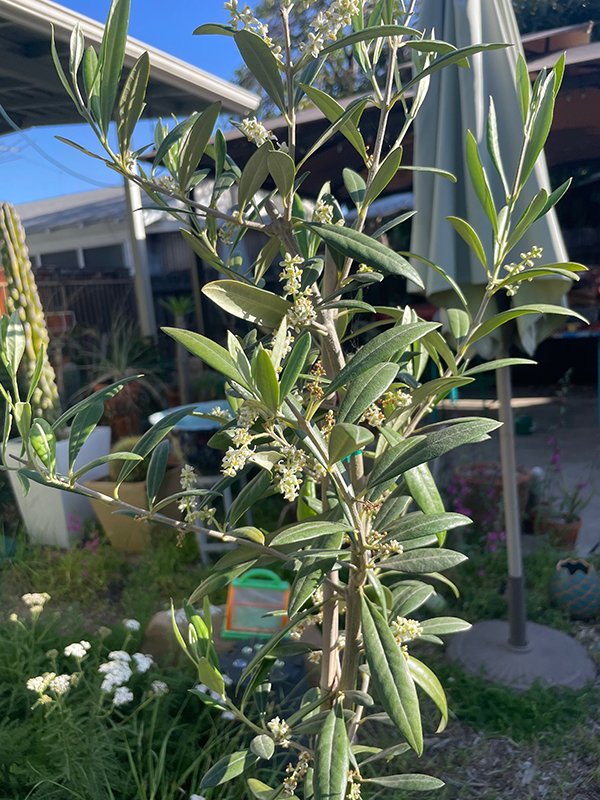

The compost has been great this year. Gigi loves to play with the pill bugs, aka rolly pollies. She has free range to explore the garden and I never know what I am going to find.
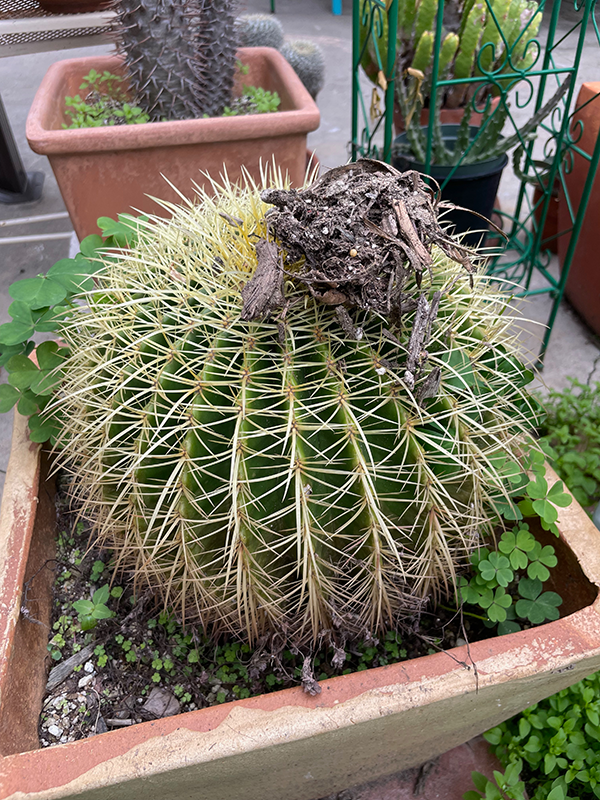
Our street is lined with trumpet trees and every March they explode in majestic pink blooms. I love this neighborhood, but springtime is magical on Homer Street. It feels like a time of renewal and happiness.
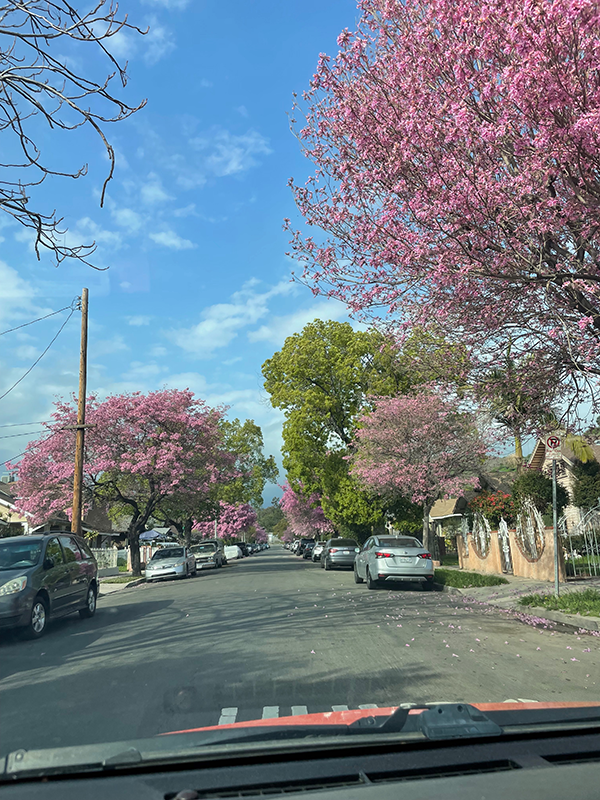
Tiny lettuce sprouts populate the ground and I tenderly uproot them to transplant inside the beds. Their roots are tangled with mycelium and I cannot begin to describe the joy I experience when I see these tendrils throughout the entirety of the garden. The soil is brimming with life.
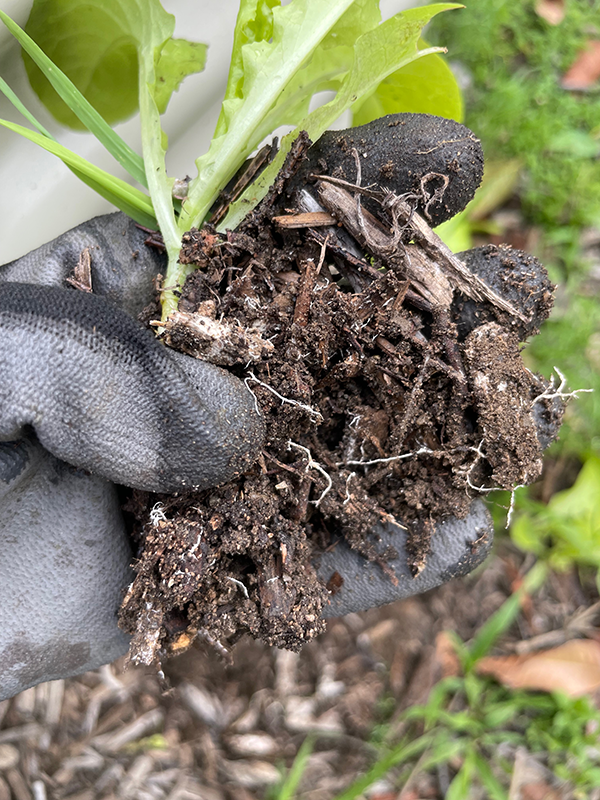
April
The backyard has exploded. It's difficult to remember that a mere eight years ago this was all concrete. Yarrow, flax, clarkia, blue eye grass and a splattering of "weeds" sprout wherever they want to. I didn't plant any of these creatures as they self-seeded from last year. All of this growth is pure chaos and I embrace it.
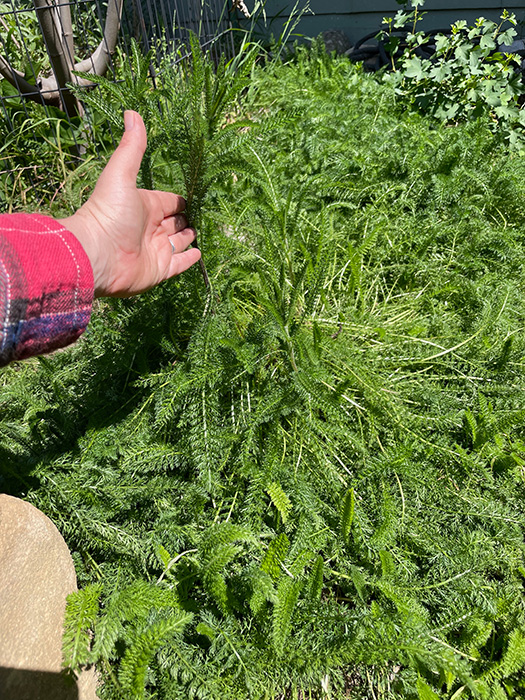
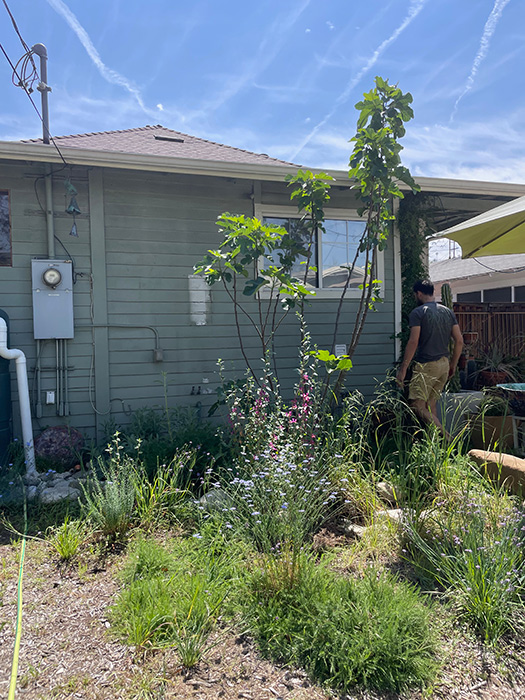
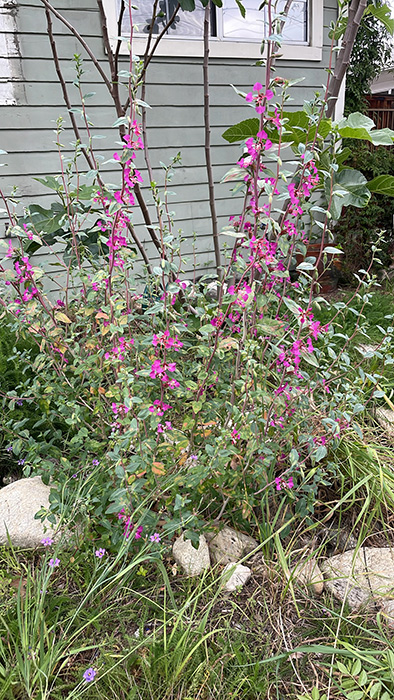
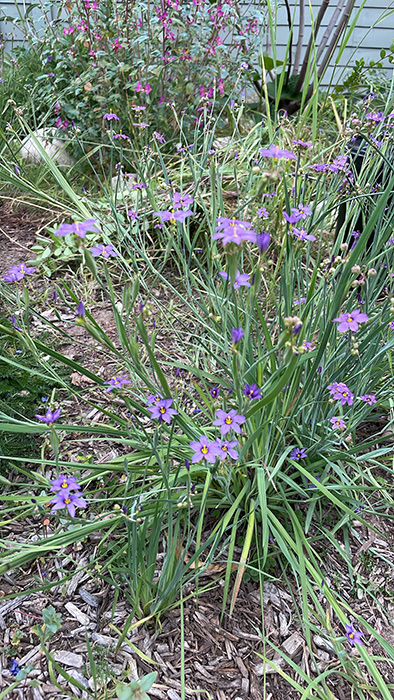
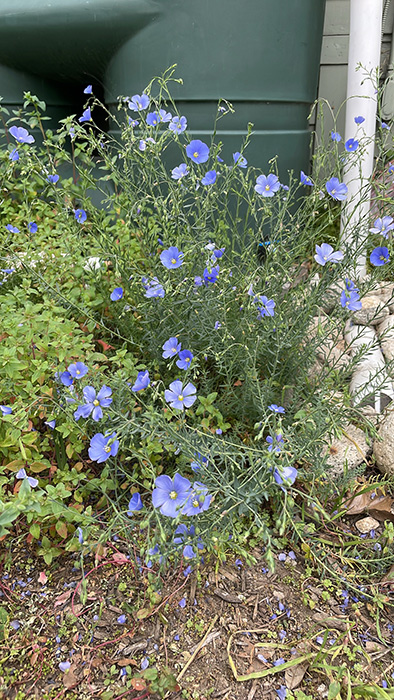

I brought back rhizomes of the petagnaea from Sicily last summer—a plant that is endemic to my ancestorial lands. I learned about this plant, its environment and the surrounding wildlife from Dr. Salvatore Migliore, a self-taught botanist who built a small and beautiful natural history museum in Longi. The rhizomes have multiplied and la petangaea fills the entire pot. I need to repot it, but I haven't gotten to it yet. Dr. Migliore died on March 17, 2025 and I still haven't let myself think of the weight of this loss. I lost a connection to that land, and that land lost an advocate. I need to process this, but not right now.
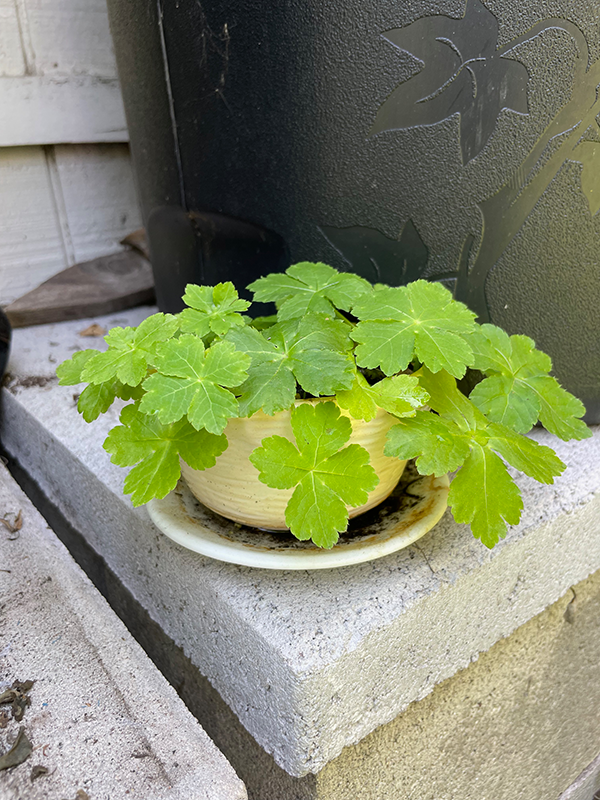
Beginning in October of this year, I will be an artist-in-residence at Art in the Park, a small non-profit 1.3 miles from my house. The year-long project will include creating and programing a garden next to the building and curating an exhibition exploring ancestorial lineages through seeds and plants. I will grow my late mother's seeds with guidance by seed stewards, elders and community members. I am in the beginning stages of preparing the space as there are many logistical hurdles, such as the scores of very cute, but destructive ground squirrels that call this place home. For Earth Day this year I met Neil Weightman at Art in the Park to prune back some bushes. Neil was the head gardener at Heritage Square Museum and I spent four wonderful years gardening alongside him. We had to leave that garden in 2019, and it feels like an optimistic gesture to be working alongside each other on Earth Day. I feel incredibly lucky for his support and that I get to work with him again in the garden.
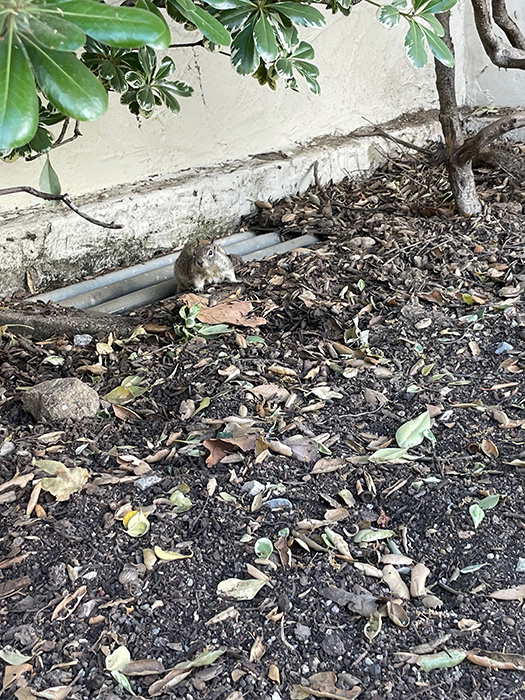
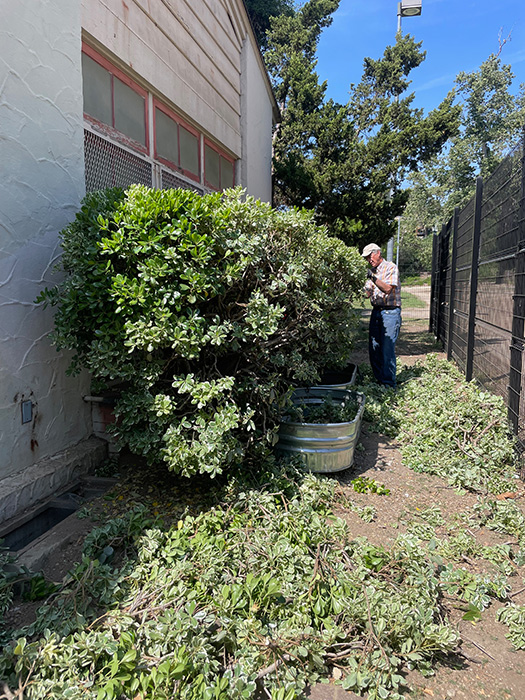
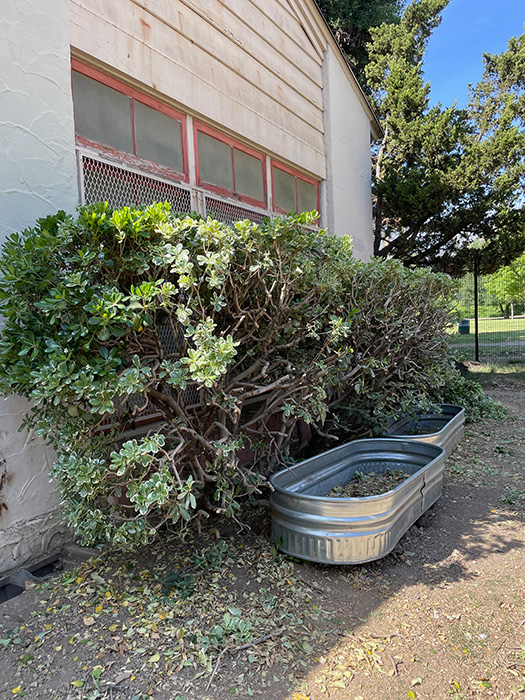
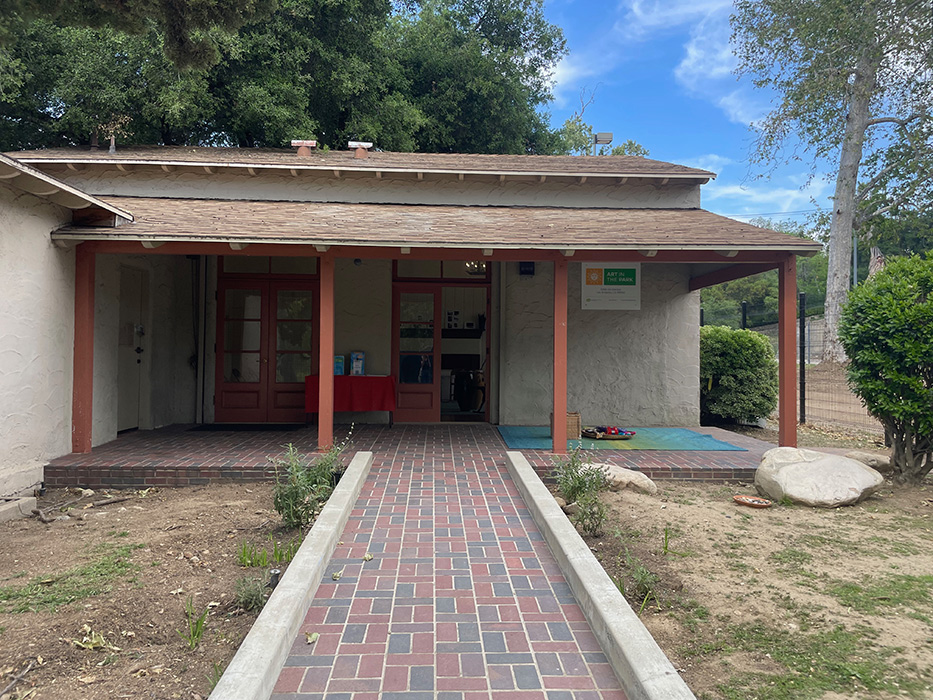
The gophers are annihilating the yard. There are holes everywhere as they destroy lush areas of yarrow. We try to flush them out the ground to no avail. We did this twice: water on full blast for about fifteen minutes.
I'm enjoying the lushness of the garden: lettuce and fennel growing in the beds, tiny loofah sprouts coming up and lounging cats.
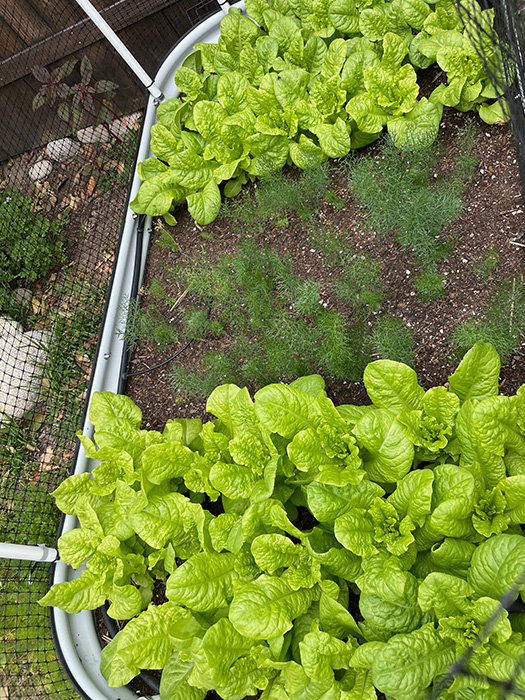
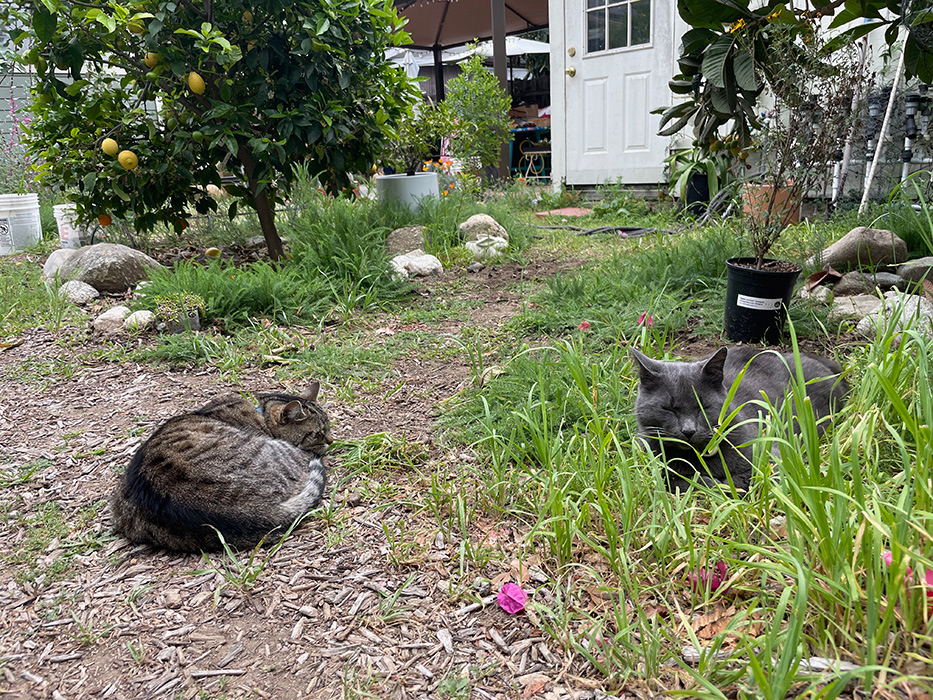
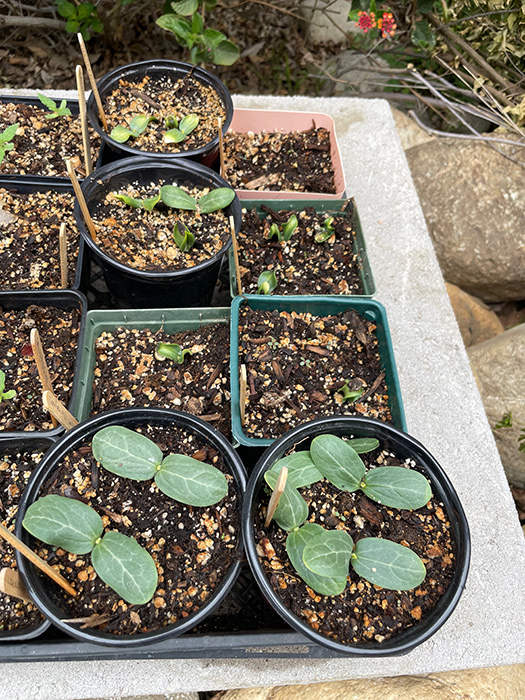
We picked the first of the capers that grow in tall pots flanking the front steps. Gigi loves capers and it feels important to show her how to take them off the plant and brine them. These are the gestures I hope she will take with her for the rest of her life.
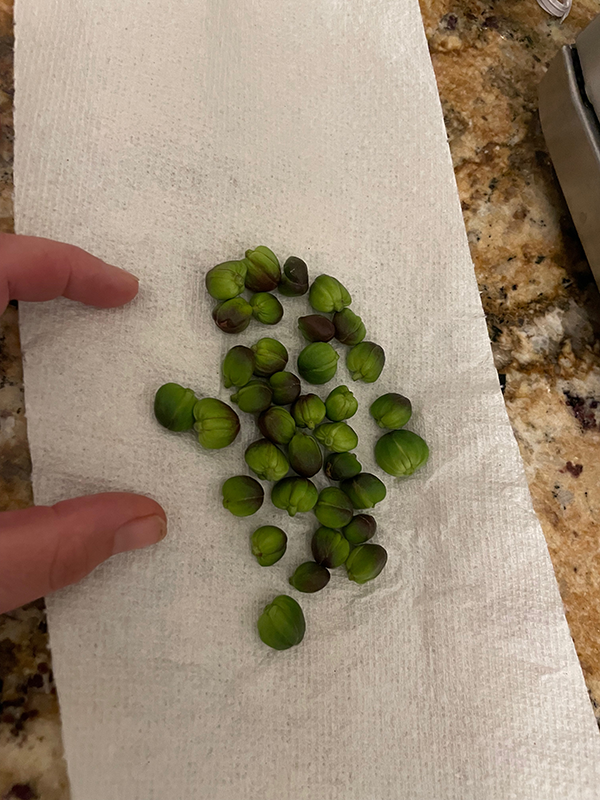
I needed to transplant a Thai red pepper plant my mother gave me ten years ago into a larger pot. As I removed the soil, I felt some ceramic pieces at the bottom of the plastic pot. My mom would always put either ceramic shards or small rocks at the bottom of pots to help with drainage. I gingerly removed more and more soil, realizing she had meticulously placed the shards over the drainage holes. My heart stopped. She's been gone for over eight years and I was not expecting to see something so intentionally placed by her hands. She created a mosaic of sorts as she repotted this pepper plant for my enjoyment and nourishment. I can imagine her stooped over the top of the pot, rearranging the pieces so they all fit. I left the shards in their resting place not knowing what to do with the nearly empty pot. I think memorializing it in this entry will make it easier for me to remove them and repurpose the materials; continuing the cycle of growth and care.
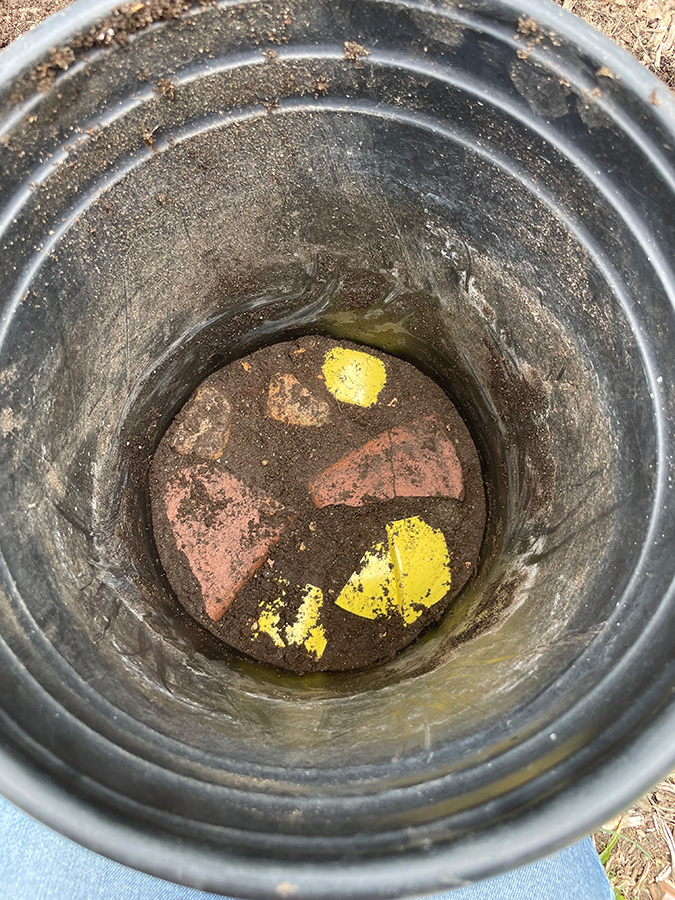
May
Gigi took a green caterpillar and put it in an enclosure—one of those kid bug saving things. I put some lettuce in it, but completely forgot about it, telling her it had died. She rebutted and showed me a cocoon attached to the furthest corner. Not knowing its timeline, I tried to check on it every few days. I was diligent enough as I noticed it had transformed into a moth but was in rough shape. I gave it some water and left the door open for it in case it had the strength to fly out. The next day it was gone. Either it did survive and flew off to start its cycle again, or it became food for some other creature. Regardless, it is part of the garden's ecosystem.
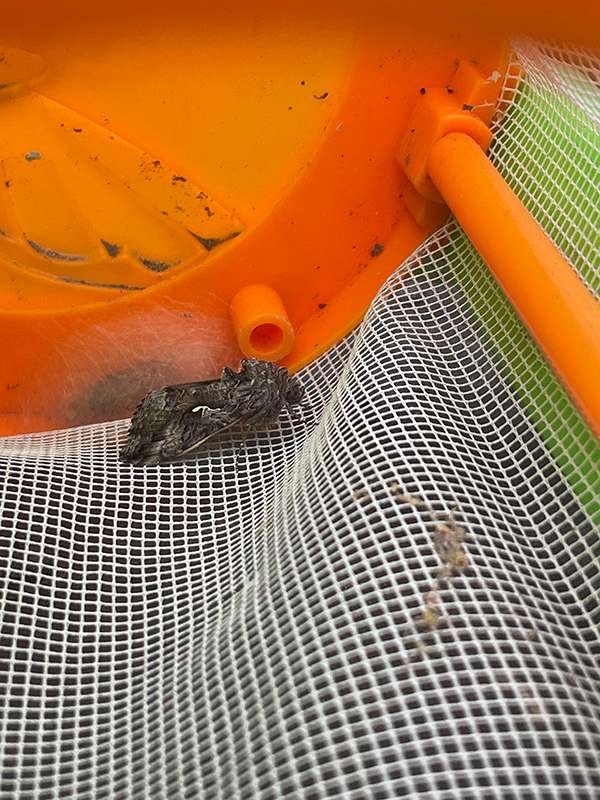
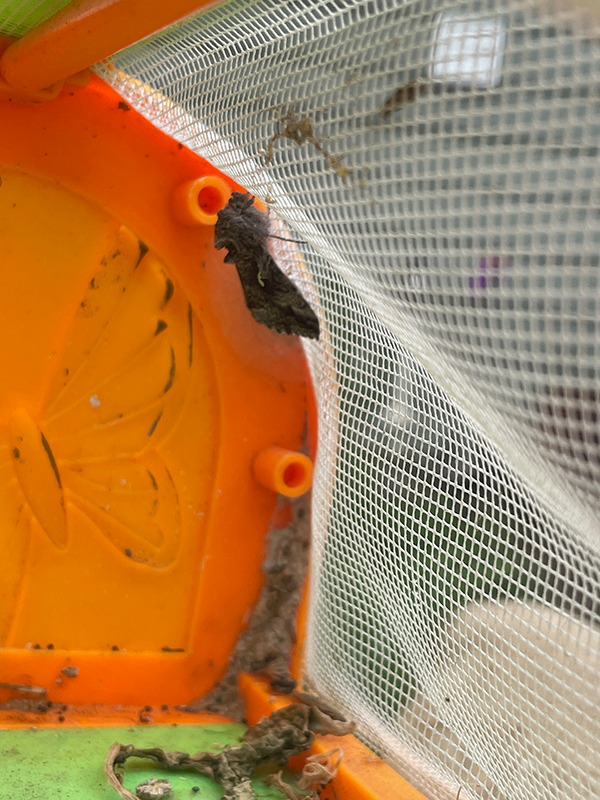
I saved cannabis seeds in 2020 from a massive plant that grew in the backyard. Somehow, only one branch became pollinated and produced seeds. Not knowing their germination rate, or how many would be female, I planted 16 cannabis seeds. Only ten sprouted and I transplanted them into gallon pots so they have more room to grow until I can sex them since I need to remove the males as quickly as I can so that the females produce high THC buds. I've been reading about the anatomical differences between male and female plants and it's hilarious to think how closely I am looking at this plant's genitals just for a high. Only through this deep looking did I notice the tiny praying mantis on the underside of a fresh leaf. I tend to have intense relationships with plants—sometimes it'll be a vegetable in the height of its season, or maybe I'll drink more tea or coffee for specific periods of time or use them for medicinal purposes like drinking nettles while pregnant. At the moment I've been consuming a lot of cannabis and it is important to me to nurture it in my garden so that way it can nurture my mind and body. This is one way to practice reciprocity.
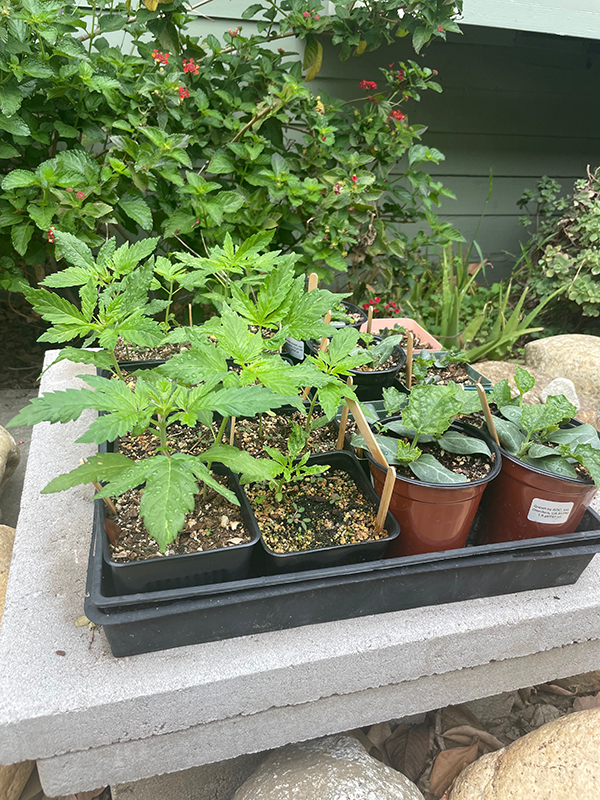
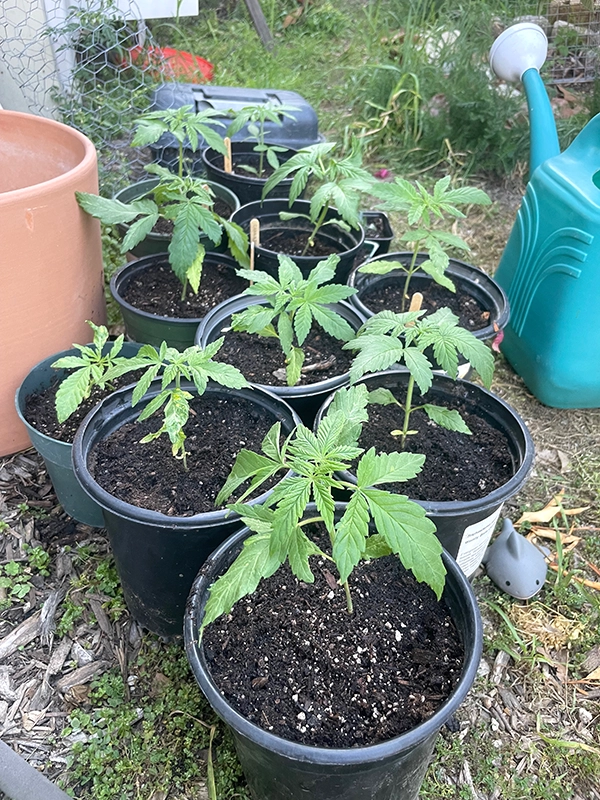
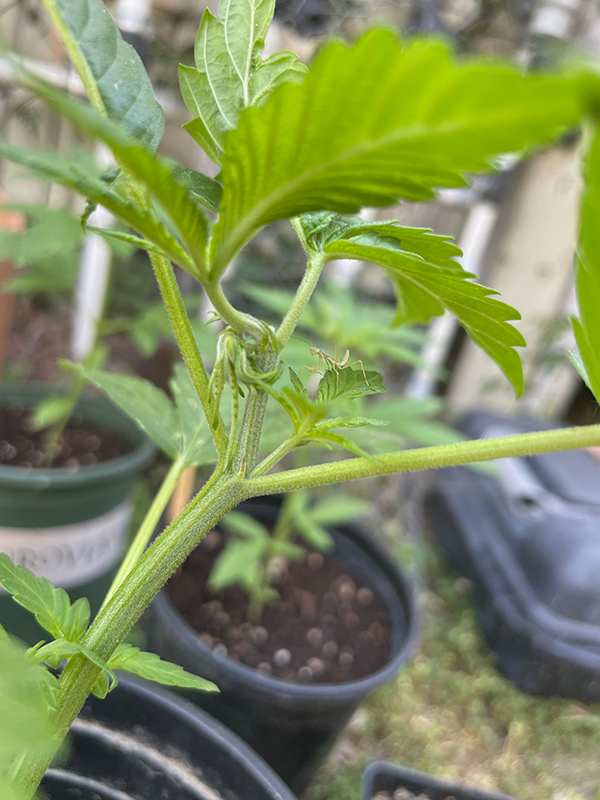
I noticed a nest outside of our back porch nestled within the mass of jasmine tendrils that climb up the side of the house. The only reason I noticed was because of the cacophony of baby birds who would erupt in insistent chirps every time a parent arrived with food. I had planned to record their tweets for this publication, and before I knew it all of them had flown the coup. Luckily Andy placed a camera on the rafter and caught several clips of the five baby finches.
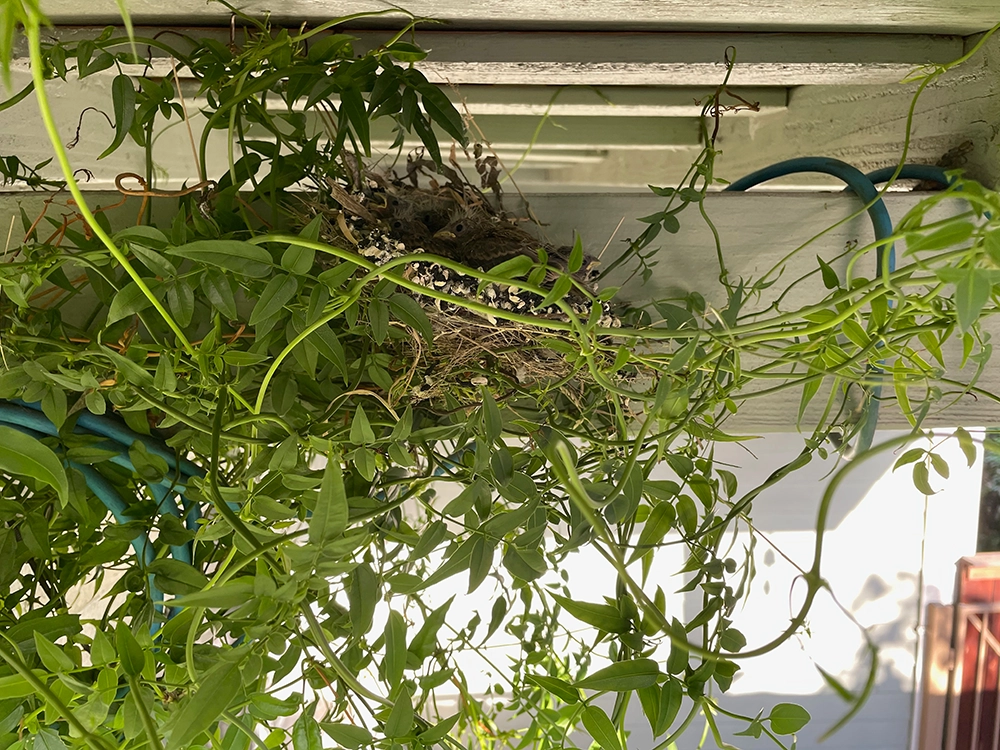
I went out one morning to water the yard and walked over to a pot where I had planted two tiny parsley plants. The pot was empty and I didn't see any evidence of them being eaten down to their roots by insects. Something caught my eye floating in a bowl of water. Two perfectly intact plants, roots and all, were submerged under water. I asked Gigi if she had mistakenly pulled them out, and she said no, but I didn't see any disturbance usually indicative of a racoon or skunk. This is my life: chaos. I cannot plan on anything sticking in the yard. The birds, gophers, insects, weather and my child all have as much, if not more authority in the garden as I do. And so, I embrace the mayhem, trying to make decisions knowing that things will most likely change, and being okay with it. Because in the end, this is where I have decided to put my attention. This is where I am practicing contentment in being able to have relationships with all of these wonderful creatures.
